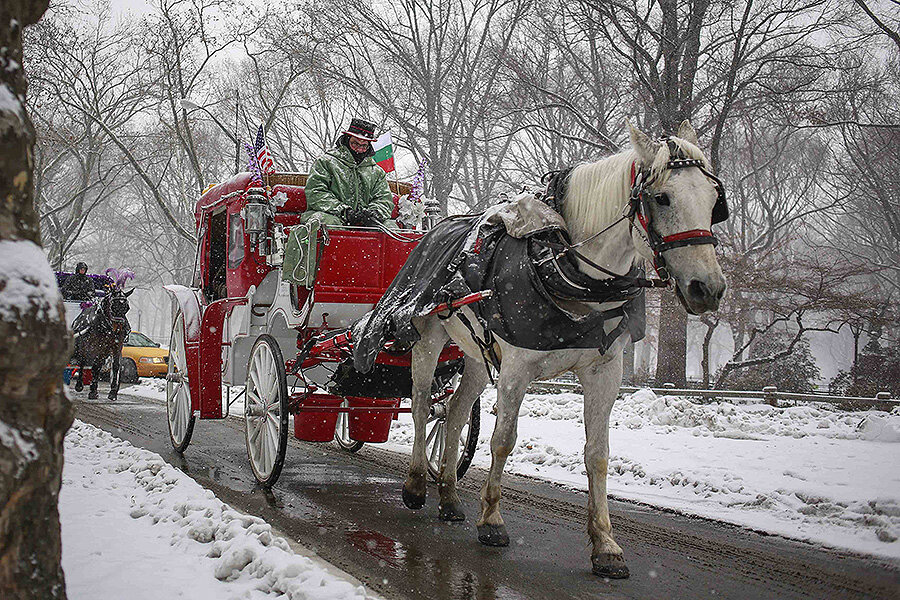NY mayor vs. horse-drawn carriages: Who won this round?
Loading...
New York City Mayor Bill De Blasio's attempt to get carriage horses off the streets of New York was dealt another defeat Thursday, when he announced that the drivers' union had withdrawn support for a deal to cut their numbers by more than 50 percent.
"With the legislation now finalized, our members are not confident that it provides a viable future for their industry," local Teamster union President George Miranda said, hours before the Mayor's annual state of the city speech, and one day before an anticipated City Council vote on the deal.
The Council has called off Friday's vote. "There were many members, including myself, who had always said that the only way I could ever support a compromise was if the Teamsters were a party to and supported the deal," Councilman Jimmy Van Bramer said, according to the New York Times.
Few New Yorkers dispute the often pom-pommed horses' iconic role in city history: for decades, tourists from around the world have come to Central Park for a 20-minute ride within approved park sections, or some streets nearby — reined in from past eras when drivers roamed farther, and New York itself was a more raucous place, compared to today's family-friendly tourist image. Starting at $165, riders intent on an extra-special ride can buy 45 minutes with chocolate and flowers.
De Blasio's proposed deal would reduce the number of drivers from 220 to 95, limit carriages to approved areas of the park, and create a newer, roomier stable, estimated at $25 million. Pedicabs, which many carriages see as competition, would have be banned from the park's southern edge.
New Yorkers oppose proposals to ban or limit the carriages by a margin of 63 percent to 25 percent, according to a January 2015 Quinnipiac University poll. What they can't agree on is what's at stake, and why it matters so much to the Mayor, whose 2013 campaign promised to get rid of the horses. "I think a humane society doesn't do that to animals," he said in April 2014.
The clearest messaging comes from animal rights group NYCLASS, although carriage workers strongly dispute the group's claims that working horses amounts to "unthinkable suffering." NYCLASS has marshaled a troop of celebrity supporters, including Edie Falco and Russel Simmons, who supported the deal as a humane way to protect horses as well as drivers, who could be trained to drive "Horseless e-Carriages" instead: battery-powered vehicles modeled on 1909 cars to provide a similar old-time feel to park visitors.
NYCLASS has also offered to pay to relocate all retired horses to sanctuaries, promising that none would be killed. Prominent animal rights groups such as the American Society for the Prevention of Cruelty to Animals and PETA also endorsed the plan.
Carriage drivers, who initially supported the deal as a way to save the industry, worried about their jobs, but also the perception that horses were put in danger or mistreated.
"They love to work," a Mennonite farmer who trains the horses in Pennsylvania, then sells them to drivers, told the New York Daily News. "God has made them for the service of mankind."
And the unions have their own unexpected supporter in the form of resident Liam Neeson, who wrote in a New York Times op-ed that childhood summers on an Irish farm taught him that "horses, much like humans, are at their happiest and healthiest when working."
"I can’t help but see the proposed ban as a class issue," Mr. Neeson wrote, echoing many opponents' claim that real estate interests, and political back-scratching, were behind De Blasio's commitment. Earlier plans to ban the carriages outright led to speculation that the stables' high-rent location was a factor. Steve Nislick, a founder of NYClass, was a former real estate executive.
Animal rights is "part of a social justice agenda," Mr. Nislick told Politico New York, calling the city's record the worst in the country.
But skepticism lingers over NYCLASS' donations to De Blasio's 2013 election campaign, when the group funded attack ads on Democratic rival Christine Quinn, the former City Council speaker.
"A selective animal-rights pose is an odd position for Mr. de Blasio, who calls himself a defender of unions and small businesses, and whose job it is to promote the city as a place for tourists," The New York Times' editorial board wrote in 2014, arguing that the city should keep its horses. "Why wipe out a well-loved, well-regulated, law-abiding part of the tourist economy?"
But De Blasio and NYClass seem determined to try again.
"Horses deserve better" @nyclass tweeted Thursday afternoon.






